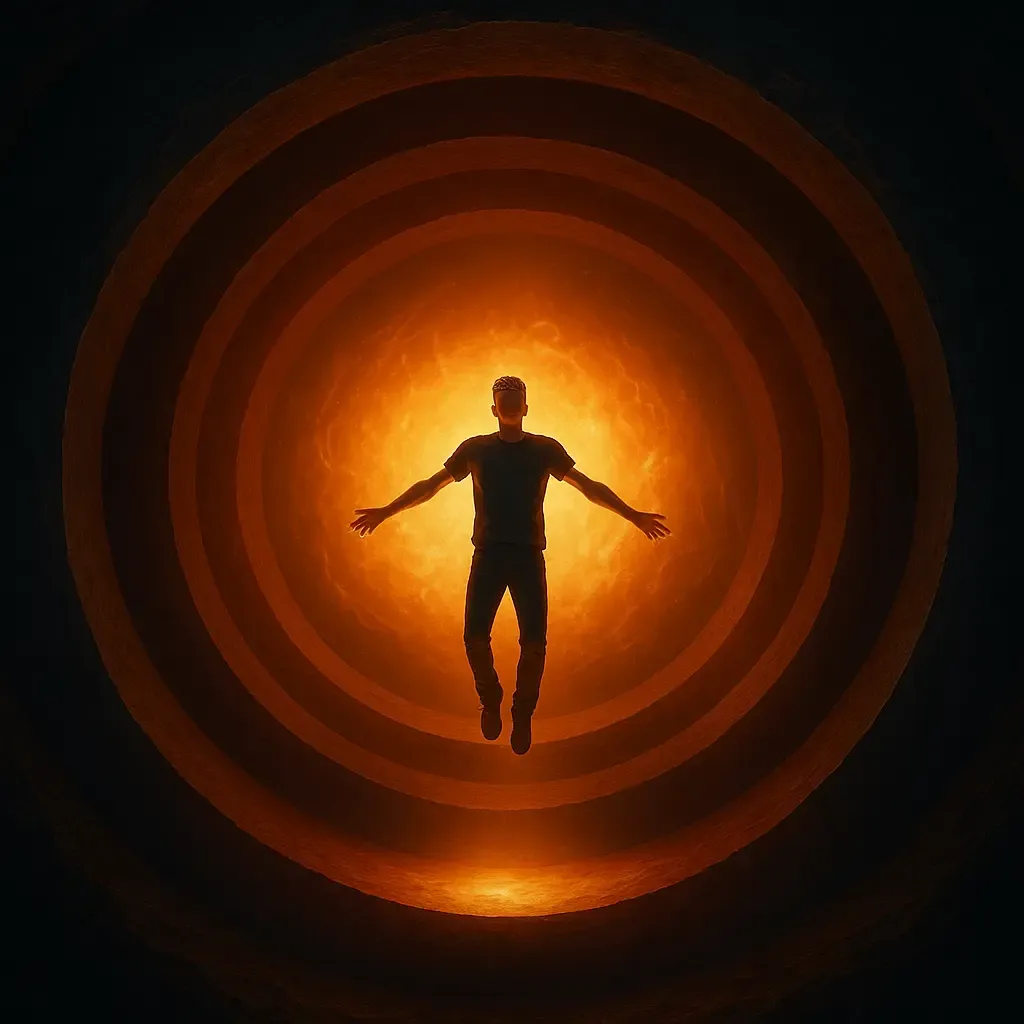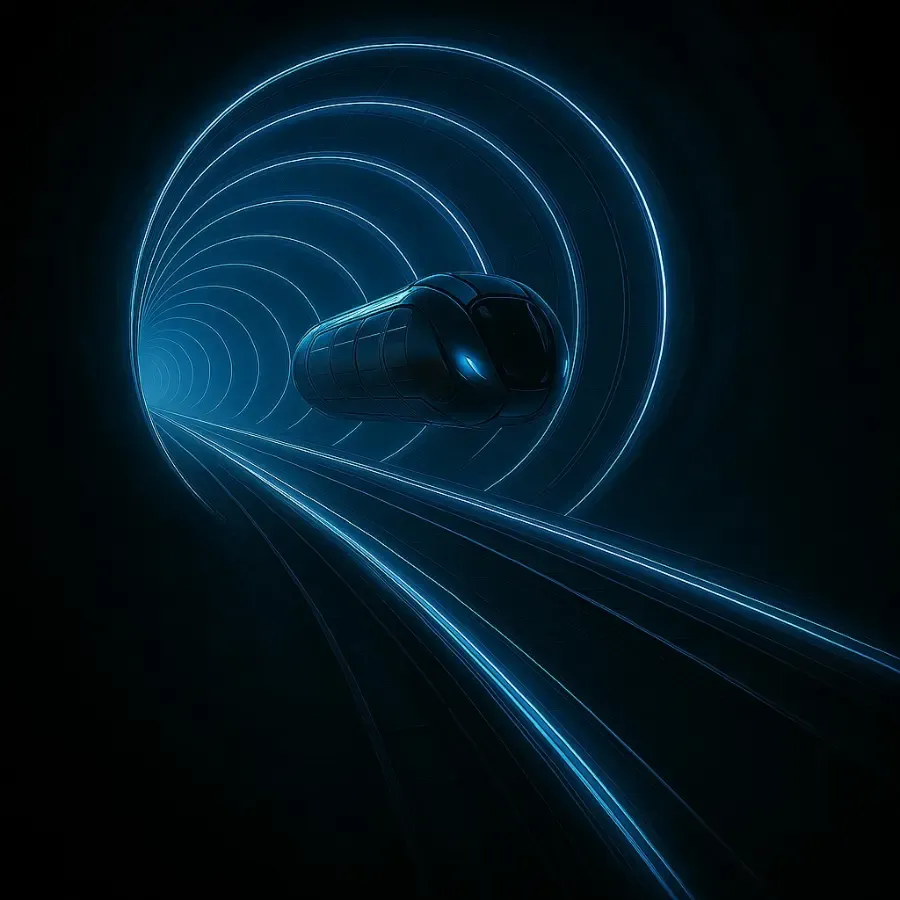Explore This Article:
- Introduction
- First Assumption: A Perfect Tunnel Through the Earth
- Gravity in Action: What Happens As You Fall?
- Will You Come Out the Other Side?
- Realistic Problems: Air Resistance, Heat, and Pressure
- What If We Used a Vacuum Tunnel?
- Bonus Twist: What If You Fell from a Side Hole?
- Final Thought: Why This Idea Still Matters
- About The Author
Introduction:
Imagine standing at the edge of a tunnel that goes straight through the Earth—no ladders, no ropes, just a clean drop from one side to the other. You take a last breath… and jump.
At first, gravity pulls you faster and faster, wind rushing past like a roller coaster with no track. But then, as you near the planet’s core, something strange happens—you begin to slow down. Will you ever reach the other side? Or will you stop somewhere in the center, suspended in eerie weightlessness?
This isn’t a sci-fi script—it’s a mind-bending physics thought experiment that’s fascinated scientists and dreamers alike. To find the truth, we’ll dive deep into the mechanics of gravity, explore the Earth’s fiery core, and challenge everything you thought you knew about falling.
Get ready. We’re going on a journey through the planet—no shovel required.lll
First Assumption: A Perfect Tunnel Through the Earth
To explore what happens when you fall through Earth, we first need to set up a perfect world.
Imagine a tunnel that goes straight through the center of the Earth—from one side of the planet to the other. It’s smooth, perfectly vertical, and free of any air, heat, or friction. There’s no magma, no collapsing walls, and no resistance to slow you down. Just an empty path through Earth’s core.
Of course, building such a tunnel is impossible with today’s technology. But in physics, starting with a simple model helps us understand the basics. This “perfect tunnel” lets us focus only on gravity and motion—no distractions.
By assuming a frictionless tunnel, we can see how gravity alone would affect your fall. It turns a complex problem into one we can actually solve. And it sets the stage for everything else that follows.
In the next section, we’ll look at how gravity changes as you fall—and why it’s not the same all the way down.
Gravity in Action: What Happens As You Fall?
Now that we’ve set up a perfect tunnel, let’s look at what actually happens as you fall into it. Gravity plays a surprising role here. It doesn't stay the same all the way down.
Here’s how gravity behaves during your fall:
- At the surface: Gravity is at its strongest. It pulls you straight down into the tunnel.
- As you fall deeper: Gravity begins to weaken. That’s because the layers of Earth above you start to cancel out the pull from below.
- At the very center of Earth: Gravity becomes zero. You’re being pulled equally in all directions—so you feel weightless.
This change in gravity creates a special kind of motion. It’s known as simple harmonic motion—the same type of movement you see in a swing or a pendulum.
What does that mean for your fall?
- You would speed up as you approach the center.
- After passing the center, you would slow down again.
- You’d reach the other side with just enough speed to stop briefly at the surface—then fall back again.
If there’s no air resistance or friction, you’d keep going back and forth forever. It’s like a human pendulum inside the Earth.!
Will You Come Out the Other Side?
So, if you jumped into a perfect tunnel and gravity pulled you in—would you really shoot out the other side of the Earth?
In theory, yes.
If there’s no air resistance, and the tunnel is perfectly smooth, gravity would pull you down to the center. You’d gain speed until you reach the core. Then, as you move past it, gravity would start slowing you down. But just as you run out of speed, you’d reach the surface on the other side.
It’s like a swing that goes up and down, with gravity as the only force doing the work. You wouldn’t stop in the middle unless something interfered. You’d keep falling back and forth between both ends of the tunnel—forever.
But that’s in a perfect vacuum. Real-world factors would change everything:
- Air resistance would slow you down with each swing.
- You’d never reach the other side fully.
- Each trip would be shorter than the last, until you settle at the center of the Earth.
Still, in a perfect model, yes—you’d come out the other side. You wouldn’t fly into the air or land standing. You’d pause for a moment… and then fall back in again.
Realistic Problems: Air Resistance, Heat, and Pressure
Now let’s step out of the perfect model and face the real-world physics.
In reality, falling through the Earth wouldn’t be smooth or endless. Several problems would stop you long before reaching the other side.
Here’s what you'd run into:
- Air resistance would hit you hard. The tunnel would act like a giant wind tunnel. As you fall, the air would push against you, slowing you down with every second.
- You’d lose speed quickly. Even if you started fast, you wouldn’t make it far before drag reduces your motion. Eventually, you’d stop—somewhere before reaching the center.
- Then there’s the heat. Earth’s interior isn’t cool or empty. The temperature increases rapidly with depth. Near the core, it’s hotter than the surface of the sun. No material we have today can survive it, let alone let you fall through it.
- Pressure is another problem. As you go deeper, the weight of the rock above increases. The pressure in the Earth’s core is over 3 million times higher than at sea level. It would crush most structures instantly.
In short, the idea is beautiful in theory—but brutal in practice. Earth’s environment doesn’t allow for such a tunnel to stay open or safe.
What If We Used a Vacuum Tunnel?
Let’s now add a twist: what if we removed the air?
What if the tunnel was sealed and turned into a vacuum?
In this case, there would be no air resistance at all. You could fall freely through the tunnel, pulled only by gravity. That means you’d reach the center at top speed, then slow down smoothly as gravity pulls you back in the opposite direction. You’d reach the other side of Earth, pause briefly, then fall back again—just like a pendulum in motion.
This is the basis of an idea called the gravity train. It’s a theoretical transportation system where vehicles could travel through a vacuum tunnel using gravity alone. No engines. No fuel. Just the force of falling.
Even better, scientists calculated that if this tunnel existed, it would take about 42 minutes to travel from one side of the planet to the other. That’s the same travel time between any two points, no matter how far apart—thanks to the physics of simple harmonic motion.
But again, this is all theoretical. Building a vacuum tunnel through Earth isn’t just difficult—it’s near impossible with our current technology. But in a future where materials can handle heat, pressure, and cost, it might not be totally out of reach.
Bonus Twist: What If You Fell from a Side Hole?
Okay, forget falling straight down. What if you jumped into a tunnel that starts from the side of the Earth instead of going straight through the center?
Now things get wild.
When you fall sideways into a tunnel that doesn’t pass through Earth’s core, gravity doesn’t act in a straight line anymore. It starts pulling you toward the center, not directly “down” the tunnel. That means you wouldn’t just fall along the path—you’d curve.
Imagine riding a slide that tilts and warps as you move. You’d start falling into the tunnel, pick up speed, but then gravity pulls you sideways—toward the center of the Earth. You’d hit the wall, bounce around, and end up wobbling back and forth like a marble in a giant bowl.
Over time, you’d settle near the lowest point in the tunnel—somewhere close to Earth’s core, depending on the angle. But you’d never come out the other side. Gravity doesn’t let you cheat like that.
And if the tunnel has air? You’ll spin, tumble, and eventually get motion sickness in 4K resolution. Not even the Avengers could save you there...
Still, it’s a fun “what if” that shows how gravity always points toward the center, no matter where you start. You can’t escape the rules… even with side-door shortcuts.
Final Thought: Why This Idea Still Matters
It’s easy to laugh off the idea of falling through the Earth. It sounds impossible—and with current technology, it is.
But that’s not the point.
These kinds of thought experiments push us to think beyond limits. They force us to imagine strange situations, apply real physics, and understand the world in a deeper way. From gravity’s behavior to the structure of our planet, you just explored big concepts in a fun and accessible way.
Even the idea of a gravity train has inspired real-world concepts—like vacuum tube travel and Hyperloop technology. What sounds like science fiction today might guide engineering tomorrow.
So, can you fall through the Earth and come out the other side?
In a perfect world—yes.
In the real world—not yet.
But in the world of imagination and physics… the journey is already worth it.
Fall through the Earth, and you’ll rise with understanding...
About The Author
Dinesh Kumar is a Physics graduate from St. Joseph's College, Tiruchirappalli. He loves space, time, and the universe. He passed the IIT JAM exam. Now, he is doing research on dark matter and time dilation.
Dinesh runs a blog, Physics and Beyond. He has written more than 40 high quality science posts. He shares big science ideas in a fun and easy way. He wants everyone to enjoy and learn science. Dinesh likes to write about space, Earth, and other cool science things. He wants to make science simple and clear.
When Dinesh is not writing, he reads about space and tries new science ideas. He cares about truth and clear writing in every post.




